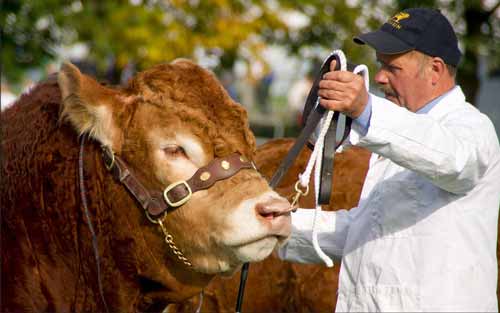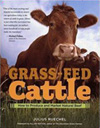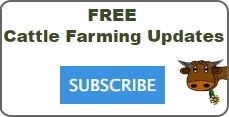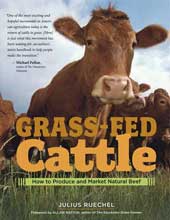Selection and Culling:
Picking Genetics for your Cattle Breeding Herd

Image Credit: Barry Skeates, Flickr, CC BY 2.0
The genetic selection of your beef cattle breeding herd is a two-part process:
overall breed choice determines whether your cattle are adapted to your climate and environmental conditions and whether your cattle's finishing weights and finishing age suit your beef production and marketing strategy;
selection and culling of individual cattle is used to select for high beef cattle fertility and low maintenance costs in your beef cattle management program.
The process of choosing the best beef cattle breeds to match your climate and production goals is covered in a separate related article here.
In this article I am going to focus on point #2; how to consistently select individual cattle genetics to maximize fertility and low-maintenance characteristics, regardless of which cattle breeds you choose for your farm. I will explain the genetic selection and culling process that will help you decide which individual animals to include in your cattle breeding herd.
Genetic selection and performance-based culling:
Selecting the most fertile and most efficient cattle for your breeding herd is a two-pronged strategy that is based on:
selecting cattle breeding stock that display a package of physical characteristics, which are indicative of high beef cattle fertility and maintenance efficiency,
and implementing a strict culling program to remove any animals that fail to perform well in your production system:
In the wild there are no humans making the final judgements about which genetics will be included or excluded from the cattle breeding herd. There are only two simple criteria that determine if any animal's genetics will continue on through the generations or be abruptly removed from the gene pool - fertility and efficiency.
Yet remarkably, these two simple criteria are so powerful that they consistently produce nearly identical-looking individuals within the entire herd, generation after generation after generation. The best efforts of human judgement during herd selection are rarely, if ever, able to produce such remarkable consistency within a herd and that consistency erodes still further as the generations evolve. It is therefore worthwhile to explore natural selection processes in nature and to understand how human judgement affects herd selection in our domestic cattle herds.
Nature's selection process
In the wild, only competition and the struggle for survival determines whether genetics survive or pass into the dustbin of history.
If you are a wild grazing species, you need to survive the winter, you need to out-compete your peers to get access to resources to prepare for the next winter, and you need to consistently produce as many offspring as possible to give your genetics the best chance of generational continuity. The most fertile, most competitive, most adapted, most efficient animals will add to the gene pool while the cattle genetics of the least efficient, least competitive, least adapted, least fertile animals will gradually disappear through premature death or lack of breeding success.
Natural selection decides what characteristics will dominate:
If wider hips, a calm demeanor, a deep chest, or a broad muzzle provide an advantage to survival and/or beef cattle fertility then they will spread through whole herd by out-competing other genetic traits that don't have these advantageous characteristics. While this natural selection process is widely known, the real trick for commercial beef producers is to learn how to identify exactly what characteristics to look for among your cattle to reveal the most fertile, most efficient animals.
Gender-specific characteristics:
It is also important to remember that the most advantageous male characteristics will be quite different than the most advantageous female characteristics because they play very different roles within the herd.
Wide hips on a cow are advantageous since she needs to squeeze a calf through those hips when she gives birth. But wide hips or narrow shoulders on a bull are not advantageous - in fact they have quite the opposite effect. A bull needs wide shoulders (front-heavy) to aid in the competitive power struggles during the cattle breeding season. However, wide hips on a bull signal a lack of masculinity (it's a feminine trait), which will cause him to throw sub-fertile offspring. In other words, the characteristics that reveal the most fertile and efficient individuals are gender-specific.
The characteristics of beef cattle fertility and efficiency are NOT breed-specific:
Luckily the characteristics that reveal beef cattle fertility and efficiency tend to be consistent across all beef cattle breeds. In other words, the traits used to identify clues about the fertility and efficiency of your cattle will be the same in all breeds regardless of the unique characteristics that allow individual breeds to adapt to specific climates.
For example, the characteristics used to identify the most fertile and efficient tropically-adapted Nelore bull or cow will be virtually identical to the characteristics used to identify the most fertile and efficient cold-climate-adapted Devon bull or cow despite the fact that their frame size, finishing weight, adaptation to temperature, and their parasite resistance will all be extremely different.
What happens when humans decide which animals to include in the cattle herd:
The difference between genetic selection in the wild and genetic selection in our domestic cattle herds is that we intervene to prevent the cruel uncompromising consequences of lower quality genetics. We don't let predators purge the herd of the weak and sickly animals. We don't let our cattle starve to death. We provide assistance when a cow runs into difficulty during the calving process. And our feed and nutritional supplements help some cattle remain fertile that would otherwise fail to rebreed in the wild. Our moral responsibility to our domestic animals and our farm's profitability depends on this intervention.
But by the same stroke, our intervention also removes, distorts or reduces the strict natural selection process that grazing species face in the wild. This causes less fertile and higher maintenance genetics to be perpetuated in our cattle herds.
The wide range of genetic variation within our domestic cattle reveals how much dilution has taken place. Wide hips/narrow hips, wide muzzle/pinched muzzle, deep chest/shallow chest, etc - all within the same gender and breed. They can't all be right... and they're not. Many of these traits reveal that less fertile, high maintenance genetics have crept into our herds as a result of our well-intentioned intervention because we didn't recognize how to subsequently remove these genetics during our genetic selection and culling process. In nature only the best-adapted survive, but in a domestic herd almost everyone survives so the quality of the genetics that are perpetuated depends almost entirely on each farmer's ability to identify and remove less ideal genetics.
In other words, your eye must replace the role of the predator and the harsh realities of starvation and their consequences during the genetic selection process.
Selecting for different markets and market trends:
Further adding to genetic variation within our domestic cattle is that not everyone is picking cattle based on the same criteria. While there are many producers that are strictly focused on producing the best genetics for beef production, some are focused on a grain-fed industry, others are focused on pasture-based performance. Change the production strategy or the selection criteria and different genetics will thrive.
Then there are breeders who are after a certain 'look' in order to compete in the show ring. Just like in the dog-breeding world, these appearance-based competitions can create their own culture where certain appearances are sought out at the expense of others to suit trends. Cattle, just like dogs, human hair length, music styles, and pant styles, are constantly changing to suit certain trends. We don't notice it from one year to the next, but compare photos of a prize Hereford, a prize Bulldog, and a kid at a rock concert in the '60's versus today and suddenly the dramatic changes in trend become very obvious.
There is nothing wrong with changing trends when those changes contribute to beef cattle fertility and efficiency in your production environment. But that's the rub... identifying if a characteristic will actually benefit your cattle's performance in your grass-fed beef production program or whether these changes are creeping in to cater to market trends and customers that have very different goals to your own.
That's why it is so vital to see the herds that you pick your cattle breeding stock from actually perform on pasture in a production environment that is similar to your own. Visit your cattle breeders at their farms instead of basing your decisions on awards or appearances in a show ring. It's only on the farm that you will see if the breeder's genetic selection process matches your goals for your beef cattle management program.
The importance of pure-bred cattle breeders:
Pure-bred breeders play an important role in the cattle industry. They are responsible for preserving the pure genetic pools that commercial beef producers draw from to create the genetic mix best suited to their individual climate, market, and production strategy.
Without purebred breeders, the unique historic adaptations of all of the distinct ancestral beef cattle breeds would be lost and replaced by a single muddled mix that no longer has an edge in any single climate. With so many different climates and environmental conditions in different beef-producing regions around the world and with so many different production strategies (even within the grass-fed industry), one size does not fit all when it comes to breed selection. Purebred breeders are vitally important to preserving the genetic diversity of the beef cattle breeds so that beef producers can source the best genetics for their unique situation.
But this wide range of genetic variation is also part of the challenge that commercial beef producers face when selecting cattle breeding stock. Every purebred cattle breeder has a different market that they cater to when making genetic selection decisions. Show ring, feedlot, pasture grazing program, and so on. And there are very different production strategies within each of these broad market categories which vary from region to region and from farm to farm according to environmental differences, different business strategies, and different trends in different regions. Again, that's why it's important to see how the genetics you are considering actually perform in a production environment that is similar to how you will raise your beef cattle. Visit your breeders' farms!
It's also important to remember that purebred breeders are also catering to the demands of their customers. If we focus on EPA scores and show ring ribbons, that's what they will deliver. But if we demand performance statistics in pasture grazing programs, then there will be purebred breeders that will cater to that demand as well. That's why it's important for grass-fed producers to be very clear about what they are looking for when they go shopping for new genetics for their herds, and communicate those demands! The marketing information on offer and the characteristics of the cattle that the breeders offer for sale will only cater to those who make their needs known.
Single-trait selection versus a balanced, comprehensive genetic package
The other cause of distortion in genetics is single-trait selection. Single-trait selection is when breeders pick genetics to accentuate specific individual traits, such as longer legs, a specific color, higher milk production, and so on. But traits do not exist in a vacuum. You cannot change one trait without affecting others, though unfortunately this interconnectedness is often not immediately apparent.
Genetics are an interconnected package. Change one trait and you change the balance within the package. It is only possible to maintain a balanced set of traits that function smoothly as a complete package when beef cattle fertility and maintenance efficiency are the core of your genetic selection process.
But when we focus on single traits, bad things happen. And they often don't happen right away; usually they only becoming apparent much later.
For example, focusing on narrow shoulders when selecting replacement bulls causes his female offspring to have calving difficulties in subsequent generations.
Focusing on accentuating milk production in some dairy breeds caused the bulls' temperament in these dairy breeds to deteriorate, making them mean, aggressive, and outright dangerous to both each other and their handlers. These unintended consequences illustrate how important it is to maintain a balanced package, which we can only do if we monitor the effect of our changes on fertility and efficiency.
Genetic selection - the characteristics of a balanced package
In order to choose the most fertile and most maintenance-efficient genetics for your cattle breeding herd, you need to identify the physical characteristics that provide clues to which animals are most likely to be the best performers. But while we use physical traits for our selection process, it is important to remember that these characteristics are only clues to future performance, not the final verdict on whether that appearance will actually translate into the best performing genetics for your herd.
The culling process described below is an equally important part of the selection process - that's where you monitor the performance of the genetics that you pick. Performance comes first - no matter how 'perfect' an animal looks, how much it cost, how impressive the ribbons, or how awe-inspiring the lineage and performance statistics of its parents - any animal that fails to perform in your production program needs to be culled, without exception. Beef production is about producing beef at the lowest cost, not about collecting fancy underperforming genetics in your pasture.
Picking your cattle starts with the art of choosing a balanced set of physical characteristics that are clues to future performance, but then testing that performance in your production system. Performance is the final verdict on your genetics - that's where you see if the clues provided by the physical characteristics delivered their suggested potential.
Genetics that deliver high fertility and low maintenance get to stay with the herd, while genetics that fail to perform are culled. You always want to skim off the bottom performers to continually improve the overall fertility and maintenance efficiency of your cattle herd.
Cows and Heifers:

Always keep your cow's role in mind when picking cows and heifers for your cattle breeding herd.
Cows and heifers appearance:
- Wide, calf-bearing hips.
- Big gut for big foraging capacity.
- Big mouth for maximum grazing intake per mouthful and maximum competitiveness within the grazing herd.
- Well-formed udder (nicely-formed teats, not pendulous, not hairy) for good milk production.
- Proportioned, balanced build.
- Feminine appearance.
- Big nostrils and wide muzzle for easy breathing.
- Calm temperament - not wild-eyed, skittish, or flighty.
- Shiny hair indicates healthy secretion of oils that help resist parasites and indicate good health.
- Healthy appearance (hair not shedding out completely in the spring is a clue to poor health even if other less obvious signs are not visible).
The parents of your cows and heifers should:
- Share the same gender-specific physical characteristics described here.
- Calve unassisted (if a calf required assistance during birth, it should automatically be excluded from your cattle breeding program as an adult).
- Perform well in a production strategy similar to your own (i.e. grass-based pasture rotation, winter grazing, summer calving, etc.) and have a history of producing calves that perform well in similar production conditions to your own.
Bulls and bull calves:

Always keep your bull's role in the herd in mind when picking bulls and bull calves for your cattle breeding herd.
Bull and bull calf appearance:
- Wide, strong shoulders, heavy, short neck, coarse head, and a muscular rump to provide power during competitive battles with other rivals during the cattle breeding season.
- Proportioned, balanced build - but slightly front-heavy (within reason) for battle with other bulls (see previous point...).
- Masculine appearance.
- Big gut for big competitive foraging capacity.
- Big mouth for maximum grazing intake per mouthful and maximum competitiveness within the grazing herd.
- A scrotum that is well-formed, equally-sized, balanced (no twist), buckskin color, and covered with only very fine, sparse hair so it doesn't overheat the sperm.
- Scrotum should be a minimum of 36 cm (14.17 inches) in diameter by the time the calf reaches 12 months of age.
- NO enlarged teats - enlarged teats on a bull are a sign of a hormone imbalance!.
- Good, obvious muscle definition - lack of muscle definition is a sign of low testosterone and consequently lower beef cattle fertility.
- Calm temperament - not wild-eyed, skittish, flighty, or overly aggressive and looking for a fight.
- Big nostrils and wide muzzle for easy breathing.
- Shiny hair indicates healthy secretion of oils that help resist parasites and indicate good health.
- Coarser, curlier, darker hair around the head, neck and lower part of his body (a sign of high male hormones).
- Healthy appearance (hair not shedding out completely in the spring is a clue to poor health even if other less obvious signs are not visible).
The parents of your bulls and bull calves should:
- Share the same gender-specific physical characteristics described here.
- Calve unassisted (if a calf required assistance during birth, it should automatically be excluded from your cattle breeding program as an adult).
- Perform well in a production strategy similar to your own (i.e. grass-based pasture rotation, winter grazing, summer calving, etc.) and have a history of producing calves that perform well in similar production conditions to your own...
And make sure you do a semen test on any bull before you buy him and every single year before the start of breeding season.
You will find a complete list of all the physical traits to look for in cows, heifers, and bulls, as well as diagrams of what the balanced male and female package should look like on pages 22 to 27 of Grass-fed Cattle.
You may also be interested in reading the article on Growing cattle, fat reserves, and future fertility to learn how to use calving date and body fat levels during the adolescent stage of sexual development to maximize the lifetime fertility of your young future breeding stock (both male and female).
When buying cattle from other breeders, it is very important to understand the nutritional factors affecting fertility discussed in the linked article above. These nutritional effects on fertility during an earlier stage of the calves' development may not be physically apparent when looking at the heifers or bull calves on sale day, but understanding the production conditions and nutritional strategies that maximize fertility and efficiency will give you a much more informed perspective when visiting your cattle breeders' farms and will provide you with the right questions to ask to unravel the nutritional history of the calves that you are assessing as your future cattle breeding stock.
Performance-based culling
The physical characteristics in the previous section are clues, not the final verdict. Performance in your production system has the final say on which cattle are the most efficient and most fertile cattle that thrive best in your climate, among your environmental conditions, and in your production program.
Culling is therefore an integral part of your herd selection process, always removing the least productive, the least efficient, and the least fertile individuals from your herd.
Choosing a balanced package of highly fertile, maintenance-efficient physical characteristics is as much an art (training your eye through experience) as it is a science. Culling is a much stricter process with very clear rules. Either an individual performs, or it does not. Period. There are some extraneous circumstances that can excuse poor performance in exceptional conditions, but they are the exception, not the rule.
Culling rules:
Culling tip
Maintain a list of animals that required treatment throughout the year so you can cull them at a future date. Give each treated animal a separate (second) red ear tag (or some other color code) at the time it is treated so you can easily identify and sort previously-treated animals from the herd on the fly without having to scroll through a long list of cattle records to find them.
- Failure to conceive during a 42-day cattle breeding season = automatic cull
- Failure to calve unassisted = automatic cull
- Failure to deliver a live calf = automatic cull
- AND, failure to produce a high-quality live calf at the weaning date = automatic cull (baring exceptional circumstances).
(Remember that the cow's responsibility for the calf, including immunity to diseases passed on through the colostrum, is not fully over until the calf is weaned!)
- Monitor body condition scores during the winter grazing season and aggressively cull high-maintenance individuals from within each age group, including from your bull herd whose performance provides a strong clue about the future maintenance efficiency of the next crop of calves!
- Excessive loss of body condition = automatic cull (i.e. any individuals that lose body condition faster during the winter grazing program than their age-matched peers are high-maintenance individuals or individuals with chronic subclinical health issues. Neither belong in your cattle breeding herd.) It's only fair to compare individuals to their age-mates; mature cows should only be compared to other mature cows, first-calf heifers to first-calf heifers, second-calf heifers to second-calf heifers, yearlings to yearlings, and bulls to bulls - because the nutritional demands and supplementation needs of each age group is different at different stages of their development and maturity.
- Flighty, nervous behaviour = automatic cull
- Illness = automatic cull. Unless there is a clear oversight in your beef cattle management strategy which caused the disease, you should always cull any animal with a history of disease because this is a high-maintenance, poorly-adapted individual.
When to cull:
Culling does not mean you instantly remove the offending animal from the herd. Flighty nervous individuals are likely best removed as soon as possible to prevent the behaviour and stress from spreading to other cattle within the herd, but otherwise it is best to keep a list of cattle marked for culling until they reach their maximum weight (and maximum value at slaughter or auction).
In Grass-fed Cattle, I discuss the best strategies to fatten cull animals, how to use them to extend your slaughter season, and what is the best time to sell cull animals, including cows that have a calf underfoot but should not be re-bred for another season.
You can learn more about selection and culling practices to ensure that you only include the most fertile and efficient individuals in your cattle herd and to ensure that you are continually improving the quality of your cattle genetics in the "Genetics and Breeding: Selecting the Right Animals for Your Herd" chapter of Grass-Fed Cattle.
Related Articles:
(Disclosure: I get commissions for purchases made using Amazon links in my post.) And when you're ready to start planning your cattle farm, check out my book: Grass-Fed Cattle: How to Produce and Market Natural Beef. Use the links below to explore my book and read reviews on Amazon: 
|



